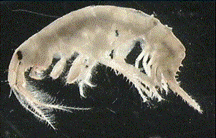|
"Your gateway to
understanding |
Amphipod
click for full size
• Discovered in Oneida Lake in 2002
• Belongs to the group commonly known as “scuds”
• Omnivorous--consumes small plants, macroinvertebrates, macroinvertebrate larvae, and leaf litter
Like many recent invaders, Echinogammarus is native to the Ponto-Caspian region (Black, Caspian, and Aral Seas) of eastern Europe and western Asia. They were first found in the Detroit River in 1995 and were introduced in ballast water discharged by transoceanic ships. They were first discovered in Oneida Lake in 2002 and currently occupy shallow water habitats. It is unknown how Echinogammarus arrived in Oneida Lake.
Amphipods, also known as “scuds” or “sideswimmers”, are tiny relatives of crayfish; adults are about ¼ inch long. They live on or near the lake bottom, feeding on microscopic plants, animals, and debris. They hide from fish under plants, among rocks, and in the sediments. Zebra mussel clusters provide suitable refuge as well. Amphipods are excellent food for many Oneida Lake fish.
There are two other species of scuds in Oneida Lake: the native Hyalella azteca and the non-native Gammarus fasciatus. G. fasciatus began replacing the native Hyalella in the 1960s and has been the most common amphipod in Oneida Lake since that time. G. fasciatus is native to the Chesapeake, Delaware, and Hudson River basins and was introduced to the Great Lakes sometime before 1940. Because of its widespread distribution, it is now considered naturalized.
To learn more about Amphipods...

